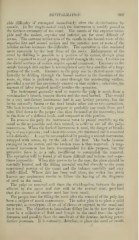Page 893 - My FlipBook
P. 893
DE VITALIZA TIOX. 903
able difficulty if attempted immediately after the devitalization by
arsenic. In the singk-rooted tuutli the instrument is readily passed to
the farthest extremity of the canal. The canals of the superior bicus-
pids and the molars, superior and inferior, are far more difficult of
acc-ess. The extreme minuteness of the canals in the buccal roots of the
su])erior first and second molars and the anterior root or roots of the
inferior molars increases the difficulty. The operation is also rendered
more uncertain by the bent form of the roots. Enlargement of the
canal by drilling is possible to a portion of its extent, though great
care is required to avoid passing the drill through the root. Cavities on
the distal surfaces of molars require special treatment. Entrance to the
canals through this surface is accomplished only by a sacrifice of a large
portion of the tooth. Entrance to the pulp can be effected more satis-
tactorily by drilling through the buccal surface in the direction of the
roots, or, what is preferable, to enter through the mastic-ating surface,
provided a cavity has previously existed on that surface ; otherwise, the
amount of labor required hardly justifies the ojxration.
The instrument generally used to remove the pulp is made from a
watchmaker's broach, temper drawn and the steel barbed. This would
be a very satisfactory instrument had it any lasting property, but the
barbs naturally flatten or the steel breaks after one or two operations.
The best instrument for this purpose is probably one made from steel
wire, filed down to the proper size, then flattened at the extremity, bent
in the form of a delicate hook, and tempered at this portion.
To remove the pulp the instrument must be passed carefully up the
canal as far as possible and then rotated, in order to cut ofl" the pulp-
connections. When the barbed instrument is used, the danger of break-
ing is always present ; and when this occurs, the fractured end is removed
with difficulty. It may be accomplished by passing a second instrument,
wrapped with cotton, up by the side of the first. The barbs become
entangled in the cotton, and the broken piece is thus removed. A mag-
netized instrument has been recommended for this purpose, but the
attractive force is, as a rule, insufficient to accomplish the removal.
The operation will be found at all times difficult and tedious, and some-
times impossible. When this proves to be the case, the piece should be
carefully located and the filling material carried directly to the most
constricted portion of the canal and the balance carefully and very
solidly filled. Where this has been well done, the writer has never
known any unpleasant results to follow the leaving of the fragment
of steel in the canal.
The pulp on removal will show the dividing-line between the part
affected by the agent and that still in the normal state, provided
that the amount of arsenic used has been small.
The proper time for filling the roots after the removal of the pulp has
been a subject of much controversy. The safest plan is to place a mild
antiseptic, as euctdyptus oil or oil of cloves or eugeuol, in the canal and
let it rest. The objection to immediate filling lies in the fact that there
must be a collection of fluid and lymph in the canal from the apical
foramen, and possibly from the canaliculi of the dentine, in\'iting putre-
factive processes. It is necessary, therefore, to place the canal or canals


